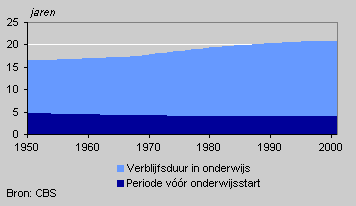Working less, learning longer

The Dutch are working less nowadays than they did half a century ago. Nevertheless, the standard of living has risen considerably over the last fifty years, partly because labour productivity has increased substantially since 1950. Labour productivity also grew because the school period was extended.
Jobs and labour volume of employees, 1950=100

Working less with more people
The number of jobs in the Netherlands has risen significantly over the last fifty years. Total labour volume in hours also grew over the same period but the increase was less significant. The reason is that full-time employees are working fewer hours and more people, in particular women, are working part-time.
In the period 1950–2002 the Dutch population grew stronger than the volume of labour. Per capita people in the Netherlands are working fewer hours than in the past. In 1984 the average employee holding a paid job worked 18 percent less than in 1950 but from 1984 the number of working hours is rising again.
The share of the employed population as a percentage of the total population has grown from 40 to over 50 percent since the early 1950s but the share of self-employed has gradually fallen. The number of jobs per one thousand inhabitants has risen by more than 50 percent but these are often small part-time jobs. The trend is that people are working less but at the same time more people are working.
Pre-school period and period in full-time education

More schooling, higher productivity
Nowadays the average Dutchman is working less but is better educated. Better schooling is necessary to increase labour productivity. The current standard of living is higher in spite of the fact that people are working less.
In 1950 people in the Netherlands on average spent 11.7 years in full-time education. Fifty years later they spent five years more in full-time education. Consequently, young people nowadays are older when they enter the labour market than in 1950. Children are also younger when they go to school for the first time. Children in 1950 averaged 4.7 years when they went to school for the first time. In the last decades children on average were 4 years old when they went to school for the first time.
Robert Selten